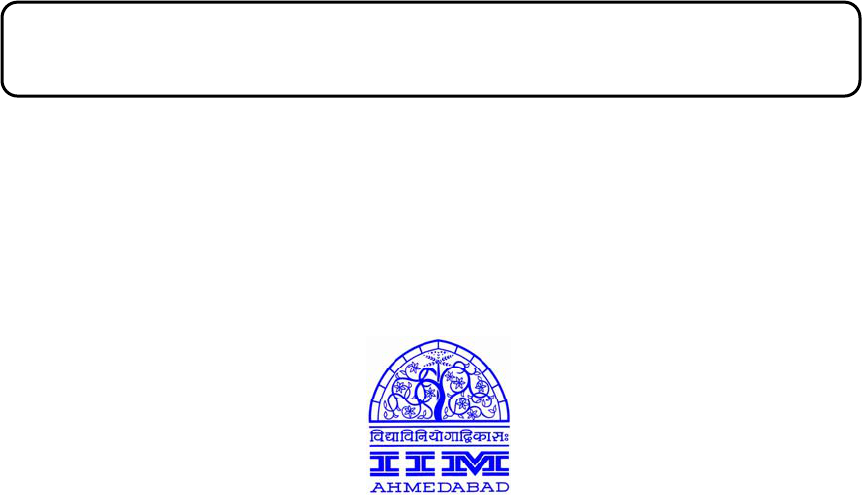
Models in Management Science: Issues in Implementation
N. Ravichandran
W.P. No.2007-03-06
March 2007
The main objective of the working paper series of the IIMA is to help faculty members, Research
Staff and Doctoral Students to speedily share their research findings with professional
colleagues, and to test out their research findings at the pre-publication stage
INDIAN INSTITUTE OF MANAGEMENT
AHMEDABAD-380 015
INDIA

IIMA y INDIA
Research and Publications
Models in Management Science: Issues in Implementation
N. Ravichandran
Indian Institute of Management
Ahmedabad – 380 015, India
Abstract
Based on an empirical analysis of several real-life case studies in this paper, we
identify the key drivers for maximizing the chances of successful implementation of
management science models. The choice of (technique) methodology used, model
sophistication, top management involvement, training and orientation of middle
management cadre in the organization, intensity of competition, perceived fear and
anxiety in implementing the new solution procedure by the front-line staff, and the
involvement of an implementation agency in the organization emerge as some of the
key elements that influence the effectiveness of the implementation process. Based
on the experience of these situations, we propose a broad framework for an
effective implementation of management science model.
Page No. 2
W.P. No. 2007-03-06

IIMA y INDIA
Research and Publications
Introduction
The ultimate purpose of an Operations Research Practitioner (ORP) while suggesting
solutions to problems is to see the implementation (and realization of the benefits
anticipated) in a real-life context. Unfortunately, such a desirable and much sought after
expectation does not get happen often, due to several reasons. It is easy to understand and
correct problems of implementation if we conceptualize the real-life problem solving
process in three different stages, viz., problem formulation and finding a desirable
solution (professional assignment to the ORP), understanding the implications of the
proposed solution in a given context (joint effort between the ORP and the organization)
and the actual implementation (a special team formed within the organization specifically
for this purpose).
Often, excellent models do not get implemented because of the complexity involved in
implementing a solution in a given context, changed conditions in which the firm or
organization operates, and the lack of enthusiasm in the organization in implementing the
proposed solution. In the Indian context, implementation is at best complex and tedious.
Only a small percentage (actual estimates are not available) of completed studies are
actually implemented. Needless to add, such poor responses to implementation lead to
lack of motivation among ORP in finding appropriate solutions to real-life problems.
Consequently our discipline does not grow in stature and importance among business
community and its credibility is eroded.
This paper is an attempt to identify (based on an empirical study) the key drivers that
contribute to effective implementation of management science models in real life. Based
on these observations, we propose a framework to facilitate their effective
implementation.
This paper is organized in three sections. The work reported here is based on our
experience (either as an ORP or as an academician) in dealing with several real-life
situations. The first section, based on these experiences, identifies a set of critical drivers
related to successful implementation of a management science model. In section 2, we
Page No. 3
W.P. No. 2007-03-06

IIMA y INDIA
Research and Publications
develop a framework to implement a formal model. We conclude this paper with a brief
description of the situations used in the research.
To begin with, it may be useful to identify the key components of the implementation
process of any management science model. They are (a) the model content and the nature
of the proposed solution, (b) the organizational context (including the industry) to which
the solution is proposed, (c) mechanisms / processes available in the context of the
organization to implement a change management process, and (d) the motivation by the
management for initiating such an intervention.
While these four components have a significant role in the implementation process, it is
useful to realize that the ORP has a limited role in influencing all the stages of the
implementation process. Often, the ORP is an outside technical expert who is invited to
provide advice on addressing a real-life problem. In case the ORP is an in-house expert,
often, implementation is influenced by the (revised) business priorities of the
organization.
Implementing Models for Management Science: Key Drivers
• Selection of an Appropriate Methodology in Modeling a Situation
In resolving a real-life situation, the ORP is tempted to use the most sophisticated tool,
technique or methodology in resolving a particular situation. Often, an ORP is driven by
an ambition to exhibit his scholarliness, in-depth knowledge and expertise on the subject.
So long as the end result and recommendations are easily understood by the relevant user,
the choice of technology and its sophistication is irrelevant. When the users are involved
in the design and development of the model, several other factors like the familiarity of
the users with reference to a particular solution, the methodology, the involvement of the
users, and the need for comprehensive detail in the modeling context would be relevant.
The situation is characterized by conflicting demands and requirements. While the user is
driven by the need to solve a problem, the ORP is motivated by the internal satisfaction of
using a sophisticated technique. An appropriate choice balancing the interest of the user,
the context, and the ability of the ORP would maximize the chance of successful
implementation. An inappropriate combination or choice would reduce the chances of
successful implementation.
Page No. 4
W.P. No. 2007-03-06

IIMA y INDIA
Research and Publications
This is best illustrated in the example of the supply chain realignment (redesign) of
Revised National Tuberculosis Control Programme. The programme was characterized
by multiple stakeholders, lack of goal congruence and objectives, and limited ownership
and responsibilities. Consequently, the system had either too much of inventory (of
drugs) or excessive shortage. The World Health Organization (WHO), which was
piloting this programme, sought assistance for improving the system. In his excitement to
improve and overhaul the system, the solution provider suggested a highly sophisticated
solution by using a combination of new initiatives like strategic outsourcing, dispensing
activities which are not adding value, and simplifying procedures with an extensive use of
information technology. While the proposed solution was the best possible under the
circumstances, the sophistication of the methodology and the lack of involvement of users
contributed to limited interest in its implementation. For political and diplomatic reasons,
WHO did not push for actual implementation. The ORP had a limited role in
implementing the new system.
• An optimal mix of contextual relevance, user sophistication, and professional
satisfaction of ORP would maximize the chances of model implementation.
In modeling a real-life situation, the ORP faces some difficult choices on the
methodology and the selection of degree of model sophistication. The real trade-off is
actually between the accuracy of the model (closeness to the real-life situation) and the
model complexity. This manifests in making appropriate choices related to linear vs.
non-linear approximation of relations used in the model; deterministic vs. stochastic
nature of representing the variables, obtaining formal closed form solution vs. developing
algorithmic procedures; and analytic formulation vs. simulation based models. Usually,
the conflict is between the professional excitement of the ORP vs. the real need for such
approaches. Again, the guiding factor in making the choice and trade-off is what is
needed for the model - the user comfort in the proposed procedure, the additional insight
obtained in the context of the model by using a sophisticated procedure. We are not
advocating a crude approximation to the real-life situation (this may well be the case if a
quick insight is needed), but propose a pragmatic orientation and approach.
Page No. 5
W.P. No. 2007-03-06

IIMA y INDIA
Research and Publications
Consider the following examples:
• The Tirupati Tirumala Devasthanam (TTD) management wanted to replace the
physical queue of the pilgrims by a virtual queue. Under the new dispensation, a
pilgrim was given a due time (date) for visit and darshan. This was made possible by
considering a model based on the average load on the system and service rate, and
arriving at an estimated time for darshan. While this model is approximate, it is good
enough to deal with the situation. Any alternate model would have made the analysis
possibly more detailed but surely would have complicated its implementation.
• Bajaj Auto Limited used simple spread sheet computations to estimate the reduction
in the wastage for various combinations of metal sheet cutting plans. Usually, such
applications are formulated as mixed integer programme. However, by exploiting the
contextual information, a far more simple approach (based on spread sheet) was
attempted.
• In the context of Sree Cement, in order to optimize the distribution cost, a planning
model was formulated as an integer programming problem incorporating origin
destination requirements and mode (rail / road) choices. However, keeping the user
sophistication into consideration, a simple heuristic approach was developed to
consider various alternatives related to logistics planning. While this could not ensure
implementation, such an approach played an important role in reducing the inertia in
adopting scientific approaches to logistics planning.
• A sophisticated simulation model to quantify the trade-off between the stock-outs and
service level for various policy parameters in managing blood bank operations evoked
very little response and enthusiasm from the blood bank administrators in a range of
hospitals. Even though the ORP felt that the model was detailed, realistic (as it
involved all appropriate stochastic elements), and was customized to specific blood
banks, the priority of the blood bank administrators was completely different and was
driven by efforts to augment supply (of blood) rather than managing demand and
supply effectively. Again, an illustration of the disconnect between the model,
priority of the administrator, the user, and the expectations and expertise of the ORP.
Page No. 6
W.P. No. 2007-03-06

IIMA y INDIA
Research and Publications
• Top management involvement is critical to implementation
Based on our experience and also the experiences reported in the literature, the single
important driver to ensure smooth implementation of a management science model is the
top management support. Actually, the top management support and the resultant
leadership style sets the pace for the implementation exercise in the context of the
organization. The following illustrations would support various dimensions related to this
critical enabler.
• The merger between Standard Charted Bank and Grindlays Bank was piloted and
monitored closely by the top management and was completed on time with expected
benefits.
• The procedure related to the management of religious procession in Ahmedabad was
substantially modified for enhanced effectiveness and institutionalized by the
leadership of top management in the Ahmedabad police department.
• The simulation experiment which quantified the capacity augmentation of Indian
Railways did not lead to any change in policy option due to lack of support from the
top management.
• The top management judgment in Hindustan Industries Limited (guided by middle
management) led them to explore seriously the resource augmentation option rather
than the process simplification option proposed by the ORP.
It is useful to realize that the top management support is not always guaranteed or focused
towards implementation of specific recommendation. It depends on the context and the
organizational dynamics. Often, studies are commissioned to understand a phenomenon
or delay a proposed solution or to manage conflicts within the organization. Also, the top
management may not have the intention of changing the status quo. Lack of appreciation
of these factors by the ORP would only lead to frustration.
Page No. 7
W.P. No. 2007-03-06

IIMA y INDIA
Research and Publications
• The implementation pace and its impact is strongly influenced by the training
and orientation of the mid-level executives in the organization.
The involvement and participation of the mid-level executives in organizations are quite
varied. Several organizations use them only to execute or implement the decisions that
are made by the top management. Some organizations involve the participation and
finding solutions to management issues. There are few very organizations that have
developed an eco-system or organizational culture by which the middle management can
participate in problem-solving. In such an environment, the middle management is
endowed with skills related to problem-solving. This can accelerate the implementation of
solution procedures proposed.
Unfortunately, in the Indian context, several organizations involve the middle
management only at the execution level. There is an acute shortage of middle level
management with appropriate skill sets in management models.
For example, Madras Refineries Limited (MRL) did not have adequate and competent
staff to formulate and run a Linear Program model for blending operations which is a
standard application in the international context. The Christian Medical College and
Hospital (CMCH) at Vellore did not have appropriate talent in the department to manage
its materials function. The same is true for Cholan Roadways Corporation (CRC) and the
Indian Railways. The passenger reservation system of Indian Railways needed skills
from outside the organization.
The limited skill level in formal management models of middle level management
complicates the implementation process and is a drag on the realized effectiveness of the
proposed solution procedure. For example, in the logistics distribution planning model
for Sree Cements, the ORP was constrained to settle for a heuristic procedure to relate the
model to the skill base and knowledge level of the functional executives of the
organization. Obviously, this is a compromise on what can be achieved (an optimal
solution was feasible).
Page No. 8
W.P. No. 2007-03-06

IIMA y INDIA
Research and Publications
• The intensity of competition accelerates the adoption of effective management
models.
The intensity of competition usually triggers two different levels of responses. The first
response focuses on enhancing the resource productivity resulting in better control on cost
and consequently flexible pricing in the market place. Enhanced resource productivity is
feasible by innovative methods of work or radically different ways of allocating
resources. Management science models are immensely suitable for such interventions.
The other response is to differentiate the product(s) and service(s) offered by the firm in
the context of industry competition. Such efforts usually require a change in the delivery
processes to identify and eliminate the inefficiencies in the system. Again, OR
methodology is a potential route to realize this improvement.
Based on our examples, Western India Chemicals Limited (WICL) was trying to improve
the cost of its logistics operations in response to the competitive environment in which it
was functioning. While the models proposed were comprehensive, the lack of cooperation
between marketing and logistics departments did not allow the organization to realize the
full potential of the recommendations. The inability of the top management to co ordinate
these two functions in the context of competition was an additional factor in not realizing
the benefits of the proposed models.
However, in the context of TTD, the competitive environment and the aggression of the
organization was replaced by the willingness of the management to convert TTD into a
pilgrim-friendly town. This desire coupled with leadership which was action-oriented
designed a new system to reduce the waiting time of the pilgrims and oversaw its
implementation.
The SCB and GB amalgamation and consolidation is a direct response to emerging
market opportunity and competitive banking environment in India. Again, as mentioned
earlier, there was an organization-wide support for the project. Able leadership, well
coordinated team work, and clear milestones led to the successful project implementation.
The materials management exercise initiated both at CMC, Vellore and CRC are direct
responses by respective organizations to the competitive environment. In both the
Page No. 9
W.P. No. 2007-03-06

IIMA y INDIA
Research and Publications
situations, the respective organizations were attempting to contain cost without
compromising on deliverables to the customer. In the implementation phase, CRC drifted
away from its objective. CMCH felt that the first phase of the project was to sensitize the
middle management on the need to control material cost and hence did not move to the
second and final stage of implementation.
• The management’s effective handling of the perceived fear and anticipated
accountability by the middle management in the context of the proposed new
solution is a facilitator for implementation.
Often, scientific methods (new or improved) tend to be system-based and are independent
of individuals who are managing the system for a long time. Also, formal methods reduce
the scope for customized solution as existed before. Usually, the middle management and
front-line staff are unsure of how the proposed new system would impact them. There is
a fear of unknown developments and improvements. There is anxiety. The combination of
all or some of these parameters motivates the middle management team to work against
the proposed solution and hence delay or derail the implementation process. The senior
management should handle these anxieties by information sharing and a coaching process
to smoothen the implementation process. Some of our experiences support this.
In the context of TTD, there were several apprehensions by the stakeholders like shop
keepers, vendors, and security agencies regarding the impact of the proposed system on
their day-to-day life. The management understood their anxiety and responded by detailed
counseling and data support to assess the impact of the proposed system on the
stakeholders which ensured smooth implementation.
In Bajaj Auto, the system driven optimized solution for metal sheet cutting plan was used
as a benchmark to evaluate the performance of the machine operators. Since the operates
believed in the superior performance of the proposed system, they readily adopted the
proposed system. Further, the operators did not view the system as a threat to their
authority but realized and positioned the new system as a win-win situation by which
their productivity and performance can be improved and, at the same time, the trim losses
can be minimized. This unique positioning of the proposed solution greatly facilitated its
implementation.
Page No. 10
W.P. No. 2007-03-06

IIMA y INDIA
Research and Publications
The passenger reservation system of the Indian Railways and the ticket accounting system
in road transport organizations were easily adopted by the front-end staff primarily
because they eased their operational responsibilities and allowed them to reconcile
accounts rapidly at the end of the work shift.
In the SCB and GB merger project, some redundancies in workforce was anticipated.
This was handled by a transparent information sharing process and a generous severance
package. By virtue of the uniqueness of the process, and involvement of stakeholders,
implementation was easy.
In the context of Sree Cements, the proposed logistics planning was positioned as a
bench-mark in monitoring the performance of the logistics group. The top management
did not adequately address the concerns of the group nor clarified the expectations.
Consequently, the implementation was not complete even though adequate training
sessions and several trail runs were conducted for the plant staff.
A Framework for Management Science Model Implementation
In this section, we propose a framework by which the implementation methodology of
management science models can be made effective.
• The ORP must assess the involvement and association of the top management in the
proposed solution. It is also important to understand the motivation for the proposed
intervention. In other words, seeking the involvement of the top management may be
the first critical step in the subsequent implementation process. Unless the purpose of
the study was only to understand a phenomenon, it may not even be advisable to be a
part of the study without top management involvement and explicit support.
• The critical need for the proposed intervention should be assessed based on the
competitiveness of the industry, the realized position of the unit, its ambitions, and the
positioning of the application in the overall context of the organizational priority.
Positive signals based on all these parameters would encourage the ORP to work on
the proposed opportunity. Alternatively, the ORP should be able to clearly and
convincingly argue the strategic importance or relevance of the proposed model in the
Page No. 11
W.P. No. 2007-03-06

IIMA y INDIA
Research and Publications
overall context of the organization and enlist the support of executives who matter in
the organization.
• The ORP must assess the scientific maturity of the mid-level and senior executives.
As explained and discussed earlier, the choice of the technique used in the proposed
methodology would be decided based on this critical input. The ORP need to exercise
his judgment between the usage of sophisticated procedures vs. useful and
understandable solution procedures from the users’ perspective.
• The ORP may want to advise and prepare the middle management regarding the
challenges in implementation from the beginning. This can be done in several form,
viz., by involving the users from the beginning on problem-solving and problem
identification, using their role in obtaining relevant data, periodically sharing with
them on the progress of the model, and, actively involving them in generating solution
options and procedures.
• Periodic training and, orientation on the usage and maintenance of the system would
be an added advantage during implementation.
• Responding to the uncertainty, anxiety, and apprehensions of the middle management
related to the new procedure is critical. The ORP along with the implementation team
should evolve a comprehensive plan and strategy to deal with this situation.
• Usually, implementation teams which are piloted by the internal team in the
organizations have been found to be very effective. A recommendation or a solution
procedure made by an ORP with very little support during the implementation phase
would drift towards no implementation.
• There may be a need to form an implementation team specifically based on the
complex nature of the application. The ORP may or may not be a part of the
implementation team based on the specified terms and conditions of the engagement.
• The major risk for any implementation process is the relative priority to the new
models in the scheme of things in the context of the organization. There is usually a
gap between the ORP proposed solution, the role of the ORP, the absence of an
implementation team, and the perceived organizational priority for the new procedure.
For successful implementation, this gap should be bridged as early as possible.
Page No. 12
W.P. No. 2007-03-06

IIMA y INDIA
Research and Publications
A Brief Description of the Situations Used in this Research
1. Cholan Roadways Corporation (CRC): In the context of this state-owned public
transport utility, the basic purpose and felt need for the intervention was a need to
have better control on cost of operations. Effective materials management (including
spares and consumables) was considered to be a significant opportunity. It was
proposed to computerize the material management system to get a better handle on
the materials function by taking advantages of developments in information
technology. The CRC has had very limited exposure of computer applications.
Almost everyone in the middle and senior management had no exposure to
management concepts, skills, and techniques. This initiative was proposed essentially
by the top management. Once the materials management system was designed, the
implementation was completely left to the departmental heads. When the
implementation was at the early stages, there was a change in the top management of
CRC. Eventually, the implementation drifted from a project to an activity of no major
consequence. The ORP had a very limited role in accelerating the pace and scope of
implementation.
2. Capacity Planning in Indian Railways: The Efficiency Bureau of the Indian
Railways - the equivalent of operations research department - sponsored a project to
study the impact of bunching of trains (passenger) of similar speed on the capacity to
carry more passengers by the same infrastructure. The need for such a study was felt
due to stagnant growth on rail network, congested rail network as a consequence of
trains operating with wide range of speed, and emerging competition from road
transport (to rail) on short distance travel of up to 200 kms. Simulation was used as a
methodology to study and quantify the impact on the number of additional trains that
can be run if the speed of the trains was made uniform or if trains with comparable
speed departed in the same time window. The study showed an improvement of up to
60 percent in capacity in several railway sections. The Efficiency Bureau brought the
details of the study, to the top management’s attention with a hope that some policy
changes on capacity management would be initiated. Unfortunately, this concept was
not received by the top management enthusiastically. Due to lack of demonstrated
political will, the follow up of the study to policy formulation did not materialize. At
Page No. 13
W.P. No. 2007-03-06

IIMA y INDIA
Research and Publications
the tactical level, the project met the stated objective of quantifying the benefits of
bunched scheduling on capacity expansion.
3. Madras Refineries Limited (MRL): The MIS department of the state-owned oil
refinery initiated and developed a linear programming model to plan the blending
operations of the unit. While the application was developed in a span of few weeks,
the attention of the top management was fully occupied with process automation-
related activities in the refinery. In fact, there was a separate project team and
eventually a department was created to plan and execute process optimization
activities. While the benefits of process optimization were evident, the initiatives
related to optimized blending operations, optimal crude sources, efficient distribution
of product, and optimal mix of refined product would only enhance the competitive
advantage of MRL. In fact, this is a standard scheme of several refineries in the
international context. However, in the context of MRL, such a progressive view was
not evident. In fact, the management decided to focus somewhat narrowly on process
optimization and spent significant time and energy in perfecting this process.
Inadvertently, what should have been a complementary set of initiatives became a
somewhat marginalized initiative in the overall context of refinery activities. Partially,
the state-owned nature of the organization contributed to these developments. Quite
expectedly, the MIS department did not consider developing any such optimization
models subsequently.
4. Christian Medical College and Hospital (Materials Management System): Being
a charity organization, the ability to control cost is an important aspect of the
hospital’s functioning. A large number of items in various categories like
consumables, pharmacy items, linen and laundry, surgical consumables, medical
suppliers, etc. significantly contribute to the cost of patient care. Over a period of
time, a large section of hospital team members like General Superintendent, Medical
Superintendent, Head of the Departments, Finance, Nursing Superintendent, etc. were
involved in managing these items. Consequently, the synergy that was possible
among them in managing this function was not achieved. There was a felt need to
bring various players together to improve the efficiency of the hospital supply system.
The scope of this intervention was to identify an appropriate structure for the
department, operating policies to manage inventory, a proper accounting system for
Page No. 14
W.P. No. 2007-03-06

IIMA y INDIA
Research and Publications
consumption monitoring, the effective ways of using information technology, and
developing an appropriate vendor sub-system. This project was conceived and piloted
by the top management of the hospital. When the recommendations were ready, a
meeting of all the concerned members was held to explore how they can bring
synergy in their working. The detailed implementation of the model was deferred.
As expected, in the next one year after the report was presented, there was a change in
the leadership with a completely new set of priorities related to the governance of the
hospital.
5. Hindustan Industries Limited (HIL) – Inplant Logistics Improvement: A study
was commissioned in HIL for improving the turnaround time of the trucks that arrive
in the facility for loading material. In the current form of operation, the truck stopped
at eight locations in the factory complex. It took a minimum of 1½ hours and a
maximum of 10 hours for the turnaround time for the truck to load the material and
leave the factory. Based on a detailed study and analysis of appropriate data, a revised
procedure to reduce the turnaround time was proposed. The revised procedure
envisaged empowered truck owners and operators, simplified accounting systems,
minimal checks and counter-checks, and extensive use of web-enabled information
technology. Under the new dispensation, a truck is expected to stop only once in the
factory complex before material loading. The new procedure compared with the very
best factory operations in the international context. The senior management team
along with the CEO of the group discussed the proposed solution. While the merits of
the proposed system were fully recognized and appreciated, the management chose to
operate with the existing conservative management philosophy. Consequently,
instead of adopting a dramatically new way of operations, the management decided to
augment the resources and facilities at various locations to decongest the bottleneck
section(s). In short, the management chose to deploy additional resources to the
system in lieu of reengineered processes.
6. Revised National Tuberculosis Control Programme (RNTCP): In response to the
poor implementation of NTCP, WHO redefined the programme objectives and
implementation details. To facilitate the process, a study was commissioned to
improve the availability of drug supply by fundamentally redefining the supply chain.
The study recommended sweeping changes in the structure, material flow, and
Page No. 15
W.P. No. 2007-03-06

IIMA y INDIA
Research and Publications
information flow. It also recommended the classic demand forecast, order, receive,
stock account and deliver the material system to be changed to a pull-based system
based on market dynamics. Extensive use of information technology, vendor
cooperation, decentralized focus of activities, and elimination of wasteful activities
were also proposed. The document outlining the proposed system was commissioned
by the WHO. However, neither the WHO nor the local implementation agency based
at Delhi gave a serious consideration to the proposed change(s). Perhaps the
implementation agency was not yet ready to handle a radical change in the process.
Under the circumstances, an incremental approach might have been more appropriate.
7. Bajaj Auto Limited: Metal Sheet Cutting Plan: Bajaj Auto Limited, a leading
player in the two-wheeler market in the Indian context, decided to explore the
possibility of minimizing the trim looses in the metal sheet cutting plan activities. An
inter departmental team consisting of members from sourcing, production planning
and control, accounts, information technology and shift engineers, was formed to
analyze and recommend a procedure. A simple spread sheet-based model was
designed by the information systems department in cooperation with production
planning control and sourcing. The solution was used as a guideline to be followed in
the shop-floor. Performance incentives were designed based on the expected trim loss
and the actual trim loss realized at specific machine locations. The savings projected
were actually audited and certified by the finance department.
8. Virtual Queue in Tirumala Tirupati Devasthanam (TTD): Concerned by the long
waiting time experienced by pilgrims and the inability to add capacity at the servicing
location (because there is
only one Balaji), the management of TTD decided to
convert the physical queue as a virtual queue. Accordingly, a set of implementation
issues was discussed, and a revised procedure was evolved and put into action. Under
the revised procedure, a pilgrim would arrive at the centre, register electronically and
show up in the main entrance of the temple at a recommended time. The physical
waiting in the queue was completely dispensed with. The revised system required
some rational choices related to hardware selection, an appropriate algorithm to
compute the waiting time, and adequate data security measures to uniquely identify
the pilgrim. The revised system also required resolving some emotional issues related
to managing the stakeholders’ (security, vendors, priests, temple management, etc.)
Page No. 16
W.P. No. 2007-03-06

IIMA y INDIA
Research and Publications
anxiety and expectation. By adopting a gradual approach to change and using data
support to enhance the credibility of the revised procedure, the implementation
process was completed. The new system is operational for the last five years even
though the senior management has changed since then at least twice.
9. The Annual Rath Yatra (religious tour) in Ahmedabad: The annual Ratha Yatra
held in Ahmedabad during March every year is an important social and religious
function. Over a period of time, the rath yatra posed several challenges to the
government related to law and order. Different political parties have used this as an
opportunity to make specific political statements. The event was marked by violence,
loss of life, and damage to property. Over a period, the top management of the police
force has evolved a robust methodology by which the Rath Yatra can be made safe
and peaceful. This involved a combination of measures including effective security
planning and arrangement, preventive measures leading to safe conduct of the Yatra,
close monitoring and effective contingency planning, and adequate deployment of
security forces. This was complemented by measures such as involving the
community, open door policy on implementation issues, stakeholders’ involvement in
the safe conduct of the Yatra, etc. As a consequence, the Yatra has been peaceful for
the past several years.
10. Western India Chemicals Limited (WICL): In response to the increasing
competitive environment and commodity nature of the product being sold, WICL
commissioned a study to explore the means and methods by which the supply chain
decisions can be better coordinated and optimized. Accordingly, an ORP developed a
sequence of formal models and optimized solutions to areas related to raw material
sourcing, deployment of trucks to ferry raw material, inventory management and
planning related to raw materials, finished goods inventory flow, inventory location,
refilling procedures, transportation mode choice, warehouse locations etc. was
developed. The top management and the departmental heads pertaining to
procurement, logistics, raw materials, and marketing discussed the proposed solution.
However, in the context of perceived competition, the top management’s effort was
spent in retaining the market share and increasing profitability. Also, the
communication gap between marketing and logistics was seen as a serious hurdle in
Page No. 17
W.P. No. 2007-03-06

IIMA y INDIA
Research and Publications
experimenting with the proposed optimized solution related to supply chain
management.
11. Decision Support System for Blood Banks: A simulation-based decision support
system was developed to demonstrate the impact of different ordering rules
(procurement policy) on service levels and wastages. The model was extensive and
incorporated several realistic measures related to stochastic nature of demand,
componenting procedure of blood, substitutability, stochastic nature of supply, etc. The
model was also customized to respond to the unique nature of individual blood banks. In
spite of the accuracy of the model, its extensive nature, user-friendly features, and
demonstrated applicability to improve the overall performance of blood banks, the
administrators chose to follow the conventional strategy of augmenting supply (blood) to
manage the affairs of the bank.
12. Shree Cements Limited (SCL): The top management of SCL identified operational
efficiency in distribution planning as a source of cost advantage. Accordingly, they
commissioned a study to improve the overall planning related to distribution of
finished goods to market. A mixed integer programming model was developed
incorporating the projected demand at retail location, the various tax considerations,
freight charges and concessions applicable based on the quantity shipped, alternate
mode choices possible, billing procedures, options and its consequences to
profitability, choice of warehouse location, etc. The proposed solution indicated
about 10 percent savings in the overall logistics cost. Since the technical expertise
available in the logistics department was somewhat limited, a user-friendly heuristic
was developed using spread sheets. The heuristic system was to be used as a
reference to plan day-to-day operations. The incentives were based on the
performance on distribution cost with reference to the heuristic solutions. Several
training sessions, demonstrations, reconciliations, and hand-holding sessions were
conducted. Even a user manual was prepared and handed over to the logistics team.
The team experimented with the new system for a while and drifted back to the old
way of planning and distribution of finished goods.
13. Amalgamation of SCB and ANZ bank: SCB purchased ANZ for strategic reasons and
in response to market opportunity in Middle East and Asia. The managerial challenge
Page No. 18
W.P. No. 2007-03-06

IIMA y INDIA
Research and Publications
post-merger was to see how these two organizations can be integrated. There was a need
to integrate products, processes, technology, structure, staff, customers, premises,
incentive scheme, etc. Several complex issues related to regulation, taxation, customer
retention, and staff redundancy were a consequence of this integration. The integration
was conceived as a large project. The top management led the effort with the support of
the staff and designated module managers. Constant de-risking and monitoring was
done to ensure the project stayed on course. The involvement of the staff, celebrating
success, transparent procedures, open and extensive communication, and responding to
employee apprehensions enabled the integration. As a consequence, the SCB - ANZ
integration is considered as one of the most successful merger proposals in the banking
history which was completed as per the original time line with associated economic
benefits.
Acknowledgement
This paper is a modified and enlarged version of a paper presented in the National
Conference on Applied Stochastic Processes organized by Department of Mathematics,
Presidency College (Autonomous), Chennai during December 15-17, 2005.
Page No. 19
W.P. No. 2007-03-06

IIMA y INDIA
Research and Publications
References
1. N.M. Balasubrahmanyam and N. Ravichandran (1986), Rescheduling Mail/Express and
Goods Trains – A Simulation Model, Proceedings of the International Conference on
Transportation Systems Studies, Indian Institute of Technology, Delhi, Tata McGraw
Hill Publishing Company Ltd, December 18-22, 1986, pp. 455-459.
2. N. Ravichandran (1989), A study on materials management computerisation plan for
Cholan Roadways Corporation, IIMA report.
3. Rekha Jain and G. Raghuram (1989), Indian Railways: Computerized Passenger
Reservation System, IIMA Case, QM 213.
4. V. Raman and N. Ravichandran (1992), Production Planning Models in a Refinery -
Proceedings of the Silver Jubilee Convention of ORSI held in IIMA; OR in India A
retrospective - pp. 89-97, Wiley Eastern Ltd, Dec. 1992.
5. N. Ravichandran (1993), A study on Logistics Management for Gujarat Heavy
Chemicals Limited, Ahmedabad, one of the three manufacturers of Soda Ash in India.
6. N. Ravichandran (1995), Bajaj Auto Limited, IIMA Case, CISG 027.
7. Kalyan Bhattacharya and N. Ravichandran (1999), Simulation Based Decision Support
System for Blood Bank Management, The 15
th
Triennial Conference, The International
Federation of Operational Research Societies, Beijing, China, August 16-20, 1999.
8. N. Ravichandran (2002), Towards World Class In-plant Logistics: Hindustan
Industries Limited, IIMA Case, Prod. 234.
9. A.H. Kalro and N. Ravichandran (2003), Towards an Integrated Materials Management
System: Christian Medical College and Hospital, IIMA Case, Prod 252.
10. N. Ravichandran (2003), Revised National Tuberculosis Control Project (RNTCP)
Reengineering Drugs Delivery System, IIMA Case, Prod. 255.
11. N. Ravichandran, Devanath Tirupati and Satyendra Kumar (2003), Bharat Cements
Limited: Optimizing Route Planning, APORS 2003, New Delhi, December 8-10, 2003.
12. N. Ravichandran (2003), Improving In-plant Logistics by Process Reengineering: Case
Study, 9th International Conference on Manufacturing Excellence, Melbourne, October
13-15, 2003.
13. N. Ravichandran (2003), Western India Heavy Chemicals Limited: Inbound and
Outbound Logistics Planning, IIMA Case, Prod. 244.
14. N. Ravichandran and Devanath Tirupati (2004), Optimizing Route Planning in Shree
Cements Limited: Problem Formulation (A), IIMA Case, Prod 260.
Page No. 20
W.P. No. 2007-03-06

IIMA y INDIA
Research and Publications
15. N. Ravichandran and Devanath Tirupati (2004), Optimizing Route Planning in Shree
Cements Limited: Towards Optimal Solution (B), IIMA Case, Prod 261.
16. N. Ravichandran and Devanath Tirupati (2004), Optimizing Route Planning in Shree
Cements Limited: Towards an operational solution (C), IIMA Case, Prod 262.
17. N. Ravichandran and Devanath Tirupati (2004), Optimizing Route Planning in Shree
Cements Limited: From Operational Solution to Efficient Systems (D), IIMA Case,
Prod 263.
18. N. Ravichandran (2005), Supply Chain Planning in a Process Industry in India: A
Case Study, Metamorphosis, A Journal of Management Research, IIM Lucknow,
Volume 4, Number 2, 2005, pp. 157-169.
19. N. Ravichandran and I.V. Subba Rao (2005), A Process oriented Approach to Waiting
Line Management in a Large Pilgrimage Center in India: A Case Study, The Smart
Manager, Vol 5, Issue 1, pp. 69-76.
20. N. Ravichandran (2005), Standard Chartered and ANZ Grindlays Bank
Amalgamation: Excellence in Execution, IIMA Case, BP 303
21. N. Ravichandran (2005), Excellence in Project Management: Lessons from
Amalgamation of Banks, INFORMS, San Francisco, Nov. 13-16, 2005.
22. N. Ravichandran (2005), Models in Management in Science: Issues in Implementation,
National Conference on Applied Stochastic Processes (NCASP-2005), Invited Talk,
Department of Mathematics, Presidency College (Autonomous), Chennai, December 17,
2005.
23. N. Ravichandran and K. Sharat Chandra (2006), Excellence in Logistics - A case study
from a social sector in India The International Conference on Logistics and Supply
Chain Management (LSCM 2006), Hong Kong January 5-7, 2006.
Page No. 21
W.P. No. 2007-03-06
